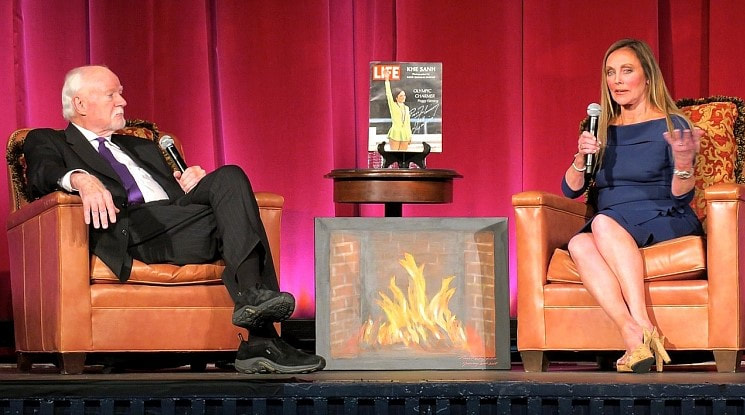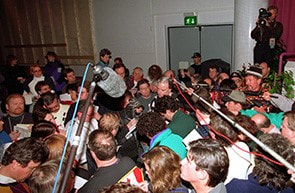|
Mike Moran was one of the giants in sports – a spokesperson for the United States Olympic Committee for decades who told the truth either with facts or with a sardonic tone and a pronounced rolling of the eyes. He was “in the room” when the 1980 Miracle on Ice transpired, and he was there when Nancy Kerrigan was whacked and when Tonya Harding was allowed to skate in Norway and he was there to explain the grandiose statements of George Steinbrenner and other bumptious officials passing through the hierarchy.
Mike was the Deep State of Olympics, and thank God for that. He passed on Tuesday at the age of 78 after a sad few months of feeling himself go downhill. He stopped e-mailing political columns and other snarky writings by others, and that was a dire sign. I could go on, but other people knew him better than I did. One of them is Bob Condron, one of the best people I know in sports, himself a professional publicist and great company in some Olympic site. Bob went on Facebook to extol his boss and friend, and I am going to desist right here and let Bob tell you about Mike Moran: By Bob Condron: A friend of mine died today. He was the library of the Olympics, as it pertained to the United States. He was the spirit of what good there was in having Olympic Dreams and reading and hearing about them. His name was Mike Moran, the spokesman of the U.S. Olympic Committee who guided the organization’s mindset for a quarter century. He was my boss. He brought me from college athletics into the Olympic Movement and my life was so rich for 30 years because of it. Mike had a variety of titles: editor of the Olympian Magazine, director of communications, Chief of Communications Officer, whatever. He came at a time the U.S. Olympic Committee had just formed by an act of Congress. The USOC was a Park Avenue kind of Travel Agency in New York. But, the Amateur Sports Act of 1978 changed all that. And it came to Colorado Springs. And its headquarters was at the old ENT Air base, the new Olympic Training Center just off downtown. Baaron Pittenger and Col. Don Miller talked Mike into coming to the USOC from the University of Colorado where he was the sports information Director. A football power with Mike riding the Buffalo wave. The USOC organization was new, the training center was new, the attitude was new. And Mike changed his life and he launched a new philosophy of trying to get the media to pay attention to the Olympics and the athletes of the United States who had dreams. He built a foundation in the early days to make sure the American media had a contact, someone who cared about small hometowns of athletes, the colleges they came from, the stories of their lives, coaches, moms and dads. But, Mike became more than that. He was the guy who stood at the podium when the U.S. boycotted the 1980 Olympic Games in Moscow. His heart broke because of it and the nastiness that came from the powers to be in the Carter administration. And he was at the podium when there was Payback four years later when the Soviet Union and the Eastern bloc said NO! to Los Angeles and the 1984 Olympics. And he was the man in the TV lights when Nancy Kerrigan was whacked in the kneecap by the Tonya Harding camp at the Olympic figure skating trials in Detroit before the 1994 Olympics in Lillehammer. He called the 1 a.m. press conference in Norway with 1,600 media in a space that probably seated 500. He was the man at the Podium for all kinds of calamities for the USOC: possible bankruptcy, investigations that wanted to make the USOC a farm club of Congress, Drug busts, George Steinbrenner, drug positives, athlete deaths, fake bios of USOC leaders, conflicts of interests by officers…fun stuff. He’d take the podium, the lights, explain things and might say…”we need to do better. Can I answer any questions?” And a hundred waving palms would rise into the air, blood vessels enlarging, right to know things, screaming at Mike. He was calm on top. Paddling like crazy underneath. But he stayed the stay. Answered every question. Met for one on ones later. He was accessible, he was the man with the quotes. Sometimes with leaders. Sometime without. Stuck on an island. He was the man who set the standard for the USOC of old. The man the media depended on to be available…at that moment. No matter whether it was the New York Times, USA Today or Bonnie Blair’s hometown paper in Wisconsin. He made this profession proud. He made me proud. He made this nation proud. He’s pain free now. Not lonely from all of his mornings at the coffee shop with six papers all prohibited by this god-awful pandemic. The poison in his body from pneumonia and organ shutdown is gone. . The 6-4 body of a former AAA pitcher that once hit Curt Flood in the family jewels as a member of the St. Louis Cardinals is forgiven. At least by God. After l:37 pm. Tuesday, he’s reading the papers now. Having coffee. Wishing the Colorado Springs Sky Sox was still a farm club of the Rockies. Writing to all the media who might have gotten credentials in Heaven . And waiting for us. * * * * * * A reporter's appreciation of Mike Moran, by Phil Hersh, long-time Olympic correspondent : http://aroundtherings.com/site/A__100353/Title__Media-Matters-Colleagues-Recall-Mike-Moran/292/Articles Comments are closed.
|
Categories
All
|











